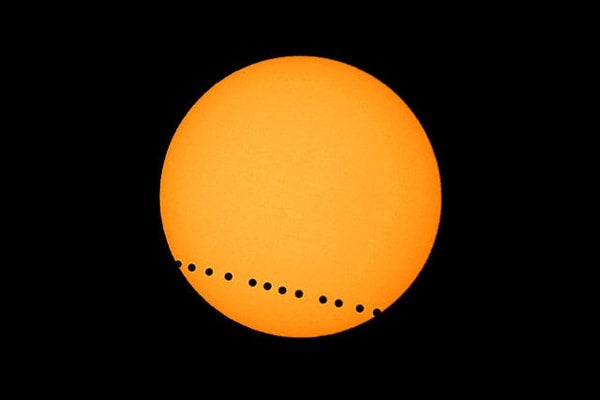
Sic transit Venus
Published: April 23, 2012
On June 5th, 2012, the planet Venus will pass in front of the Sun as seen from Earth in what for many will be a once-in-a-lifetime event: a transit of Venus.
The transit will be visible across Canada and in other parts of the world, and is already garnering global attention.
But should you care?
“The last transit of Venus occurred in 2004. If you missed it, this year’s event will literally be a once-in-a-lifetime experience as the next transit of Venus won’t occur until 2117,” said Professor Michael Reid, Director of Education & Public Outreach at the U of T’s Dunlap Institute for Astronomy & Astrophysics.
“What’s more, transits have great historical and contemporary significance,” said Reid. “In the 1700s and 1800s, transits of Venus gave astronomers their first accurate measurements of the distance to the Sun and Captain Cook observed the 1769 transit from Tahiti. Today, astronomers use transits to find planets outside our Solar System, known as exoplanets.”
Reid is one of the speakers at U of T’s Transit of Venus symposium April 28, 2012, organized by the University’s Dunlap Institute for Astronomy & Astrophysics and Institute for the History & Philosophy of Science & Technology, and with the support of the Department of Astronomy & Astrophysics. Keynote speakers will be: Jay Pasachoff, renowned researcher, astrophotographer, science communicator and transit expert; and Professor James Graham, director of the Dunlap Institute for Astronomy & Astrophysics.
“Given the widespread interest in this rare event, we’re bringing together experts who will present talks on a wide variety of transit-related topics of interest to scientific and academic communities, educators, as well as journalists planning on covering the June 5th spectacle,” Reid said.
Topics include: the centuries-long history of transits and the expeditions to observe them; how to view the transit safely; incorporating the transit into school math and science curricula; and the connection between the transit of Venus and the search for planets around distant stars.
“When an exoplanet passes between us and its parent star—when the planet transits the star—the star appears to dim slightly,” Graham said. “By measuring the amount and duration of the dimming, and the interval between subsequent transits, astronomers can determine the size of the unseen planet and its orbital distance from the parent star.
“This allows us to determine whether a planet is small, like Earth, and whether it orbits at the right distance from the star so that it is neither too hot nor too cold for water to exist in liquid form and hence whether it might support life.”
Many researchers at U of T are involved in the search for exoplanets. Dunlap post-doctoral fellow Quinn Konopacky was part of a team that, in 2009, discovered a fourth gas-giant planet around a star in the constellation Pegasus, making that planetary system similar to our own. Dunlap post-doctoral fellow Nicholas Law leads a variety of projects to detect transits of M-dwarf stars. And Graham is Project Scientist for the Gemini Planet Imager which will survey roughly a thousand of the nearest stars in order to record images of any Jupiter-size exoplanets in orbit around them.
Also, U of T astronomer Ray Jayawardhana and his former student Bryce Croll are using telescopes on the ground to measure the chemical make-up of exoplanets. A Canadian team including Christian Marois, David Lafrenière, René Doyon and Bruce Macintosh took the first actual picture of a system of exoplanets.
Jayawardhana, Lafrenière, and the University of Toronto’s Marten van Kerkwijk published the first-ever picture of an exoplanet orbiting a Sun-like star.
The U of T symposium will be held in Alumni Hall of St. Michael’s College on the University’s St. George Campus, 121 St. Joseph Street. Sessions begin at 10am and end at 5pm. The symposium will also include a tour of a new exhibit of astronomical instruments as part of the University of Toronto Scientific Instrument Collaboration. Symposium attendance is free and no registration is required.
For more information about the symposium and to see a detailed agenda: http://universe.utoronto.ca/special/transit2012
To read more about planet hunters at U of T visit: http://www.magazine.utoronto.ca/feature/planet-and-solar-system-formation-exoplanets-dunlap-institute-ray-jayawardhana-james-graham-patchen-barss/



